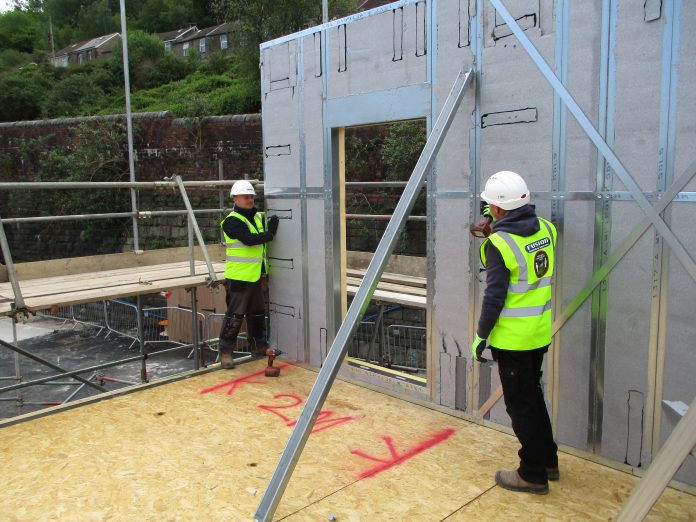Fusion Building Systems, a well-established light steel frame superstructure manufacturer, celebrates two decades in the offsite construction sector this year. Head of business development Robert Clark discusses the changes the industry has seen since the year 2000 and takes a look at what’s yet to come
Offsite construction, or Modern Methods of Construction (MMC), has risen in popularity over the last few years – largely because it offers a solution to our country’s housing crisis: the option to build high quality new homes, quickly, in factory-controlled environments, using fully integrated supply chains.
But while many new names and faces have appeared on the offsite scene as the opportunity for growth has become apparent, at Fusion we’ve been designing, engineering and building this way for a little longer and for a wider range of end user markets.
Here’s what we know…
There’s nothing new about offsite construction, even if we are calling it “modern”. The concept of designing and building something in a factory and then shipping it out to site has been around for years, it’s just that the construction industry hasn’t taken much notice before now.
Fusion Building Systems was founded in Ireland in 2000 when a construction entrepreneur wanted to find a way of delivering high quality housing at speed, with less reliance on labour and the weather. Offsite was very much a fringe technology then, with very few large-scale projects being undertaken but gradually, over the next five to 10 years (during the “credit crunch”), offsite did start to develop green shoots in some niche areas, indicating signs of its acceptance as a viable construction solution.
In 2010, Fusion was acquired by Salvesen Insulated Frames with my colleagues Tom Salvesen and Mike Fairey as co-directors. The business relocated to Northampton, where we still are today and settled in for what would become a decade of change.
Around five years ago, in 2015 we started to see an increased growth in demand for student accommodation, build to rent (including private rental schemes (PRS)) and hotels – sectors where speed of build has value. These sectors may not be operating on the scale of volume housebuilding, but they’re no longer fringe and they demand a fast, reliable, quality build, completed on time.
Then, thinking back over just the last two or three years, it’s been a different story for offsite. The sector has grown exponentially with new systems, solutions and materials being used. Most of these new providers are still in their heavily cash-intensive set-up phase, with significant sums of money invested to hopefully be recouped. The risk with this, though, is whether the construction industry is ready to change its ways and adopt a ‘new’ way of building.
At Fusion, we’ve built more than 25,000 structures over the past 20 years, so we’ve got a good idea about what works and what doesn’t. Experience has also taught us the importance of having a client who drives a fully integrated supply chain. This is where issues often lie. For offsite to work, every single contributor in the supply chain must understand how they connect into the system and the main contractor needs to be leading the education and communication for every partner.
I’ve worked on projects with some of the UK’s largest builders and once they get to know our system and the benefits it can deliver to their entire programme, and to the bottom line, they ask why they would ever want to build with anything else. But that education doesn’t exist everywhere. You can have the flashiest marketing campaign, the best technology and the shiniest product, but if the main contractor and other supply chain partners don’t fully understand what’s all about, it won’t work.
At the moment, construction projects are labour-intensive and productivity lags relative to other sectors. It is changing, slowly, but the shift from traditional methods of construction to adopting offsite solutions on a large scale is immense. But we do have the technology and we can transfer knowledge from other industries to help us improve output, quality and sustainability.
Taking a leaf out of the automotive industry’s book, the government has stated construction would benefit from moving towards a manufacturing-led approach – viewing output as a product rather than a project, and offsite provides the ideal environment for making this happen.
For some time now, we’ve been promoting this approach, JeDu as we call it (moving from proJEcts, to proDUcts), encouraging contracts where we can to standardise designs to enable speed of build, a better quality end product and an integrated supply chain.
Basically, stop starting from scratch with each new project and start replicating success stories, using the same product. We’re starting to see this integration of supply chains in the offsite sector becoming more widespread, with some companies supplying specific products such as plasterboard and fire stopping all under the same ownership, while others are creating supply chain partnerships to offer to main contractors as a full package. This delivers on our JeDu philosophy and would see the construction industry take better advantage of the full benefits that offsite methods can deliver.
Of course, 2020 has been an unimaginably tough year for everyone and while some opportunities may have presented themselves, the construction industry hasn’t escaped the global challenge of Covid-19. We published a news story during lockdown about the completion of a project we were working on in South Wales.
The photo we issued with the story showed two of our installers erecting a light steel frame panel on site, while keeping the required 2m distance away from each other. The point we demonstrated through this was because offsite methods of construction required so few personnel to be on site, projects have been able to continue because social distancing it seems, is already part of job.
The ‘new normal’
While this is one small, standalone example, it opens the floor for discussions which are happening on virtual conferences calls up and down the country. How can the construction sector adapt to this “new normal”? What can we do differently? What solutions are available now?
There have been many discussions in media commentary that the Coronavirus pandemic has accelerated a move towards widespread homeworking, to the development and adoption of emerging technologies, for example, before they might otherwise have happened. In an article I wrote only a year or so back, I said I expected to see a rapid adoption of offsite methods of construction over the next five years, so it will be interesting to see if this too finds itself on a path of accelerated growth.
The construction industry is heading towards a future centred on integration and producing standard, quality products. I accept we’re working in a very challenging economic climate at the moment but I’m excited to see how this will materialise, and how the timeline for Fusion and the offsite industry as a whole will perform over the next five, 10 and 20 years.

Robert Clark
Head of business development
+44 (0)1604 490540
Twitter: FusionBuildLGS
YouTube: FusionBuild














